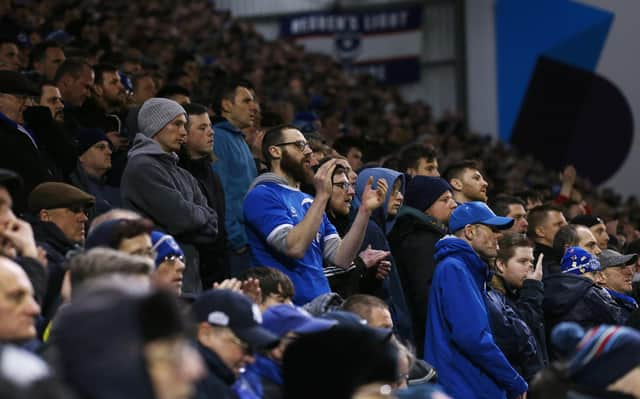Opinion: Solution to get Portsmouth fans back to Fratton Park needed - not government bailouts


But that’s exactly what greeted those of us who have time for a bit of telly before work on Tuesday, with Pompey chief executive Mark Catlin welcoming Good Morning Britain to Fratton Park in the early hours and Tranmere chairman Mark Palios playing host to BBC Breakfast.
With the PO4 floodlights illuminating the morning sky, local residents must have thought Kenny Jackett had scheduled a punishing pre-dawn training session for his players after that disappointing Wigan defeat.
Advertisement
Hide AdAdvertisement
Hide AdInstead, though, off-the-pitch concerns were taking centre stage rather than those currently inflicting the Blues on it.
With football clubs the length and breadth of the country facing a precarious future financially due to the impact of coronavirus, both Catlin and Palios were highlighting the problems their respective outfits have endured since lockdown measures were introduced back in March – and the consequences they could face in the very near future if fans continue to be left outside grounds until possibly March 2021.
Pompey, alone, are haemorrhaging up to £750,000 a month.
How long a club like the Blues can continue to operate with such losses remains anyone’s guess.
Meanwhile, we’re constantly reminded that other clubs in leagues One and Two, who are a lot worse off financially, could easily fold if a solution is not found.
Advertisement
Hide AdAdvertisement
Hide AdHence the pleas for government bailouts – and help from the Premier League to ensure the survival of certain well-established teams.
However, my main concern with government intervention is that football is not the only sector looking for much-needed cash. There’s a queue growing bigger by the day, with other industries looking for some form of assistance.
Prime Minister Boris Johnson and Chancellor of the Exchequer Rishi Sunak surely can’t help them all. There’s not a bottomless pit of money, while someone is going to have to pay for it eventually.
In that case then, the best course of action must be to find a a way to get fans back into the stands – albeit at reduced capacities.
Advertisement
Hide AdAdvertisement
Hide AdThe newest national measures to tackle the spread of coronavirus are necessary, in my opinion, as infection rates grow exponentially.
However, surely there’s enough desire to make match-days with fans and restrictions on numbers imposed by government compatible – especially at tiers three and four, where the restrictions are hitting home the most.
The government’s current approach that all fans of elite level football should stay away is a one-size-fits-all stance.
But a match-day at the likes of Accrington, Stevenage, Morecambe, Oxford United and Pompey, for that matter, differs greatly from that at Chelsea, Arsenal, Liverpool or Manchester United.
Advertisement
Hide AdAdvertisement
Hide AdWhile those Premier League clubs normally attract upwards of 60,000-70,000 fans – from all round the world – descending on a particular area, travelling via the tube, train, bus or car, filling the streets outside grounds, packing local bars an restaurants, stretching resources, and making social distancing almost impossible – it’s doesn’t have to be that way at lower league level.
With clubs like Accrington, Burton and Fleetwood averaging crowds of between 2,800 and 3,200 last season, measures both inside and outside the ground could be enforced and managed sufficiently to ensure people kept their distance and were being offered a safe environment.
And don’t forget, the probability is the majority of their supporters live within a reasonable walking distance of their stadiums. So concerns about a mass influx of people from outside a particular area arriving are automatically reduced.
No away supporters would be granted access, either.
The same could apply to clubs like Shrewsbury, whose average attendance was around 6,000 last term.
Advertisement
Hide AdAdvertisement
Hide AdPompey, with a mean attendance of 17,804 for the curtailed 2019-20 campaign, would obviously not be able to host that figure on a match-day at present.
Nor would they be able to welcome those thousands who travel in from the likes of Fareham, Gosport, Chichester and beyond on the local the train network.
But both the club and Fratton faithful would welcome a temporary reduction in numbers in order to return to some form of normality – the 12,000-plus supporters who signed up for a flexi-season ticket would vouch for that!
Enough work has gone on behind the scenes by clubs to make stadiums Covid-secure.
Advertisement
Hide AdAdvertisement
Hide AdAnd with careful management via the help of local authorities, surely a workable system can be deployed outside stadiums to ensure fans’ safety – both upon entry and exit.
There’d be no scenes similar to those at the Cheltenham Festival back in March or Liverpool’s Champions League clash with Atlético Madrid – two sporting events which experts believe contributed to the spread of coronavirus back at the start of the year.
Rather, we’d witness a controlled environment – alcohol free, if needs be – where fans can once again return to grounds to support their teams.
Non-league sides have the capacity to welcome back supporters in a control manner.
Advertisement
Hide AdAdvertisement
Hide AdSo why can’t clubs in leagues One and Two do the same – especially when their existence depends on it?
A message from the Editor, Mark Waldron
Thank you for reading this story. The News has launched a new subscription offer which gives you unlimited access to all of our Pompey coverage.
You can subscribe here to get the latest updates from Fratton Park, transfer news and expert analysis from our team of Pompey writers.
Every subscription helps us continue providing trusted, local journalism on your behalf for our city.
Comment Guidelines
National World encourages reader discussion on our stories. User feedback, insights and back-and-forth exchanges add a rich layer of context to reporting. Please review our Community Guidelines before commenting.